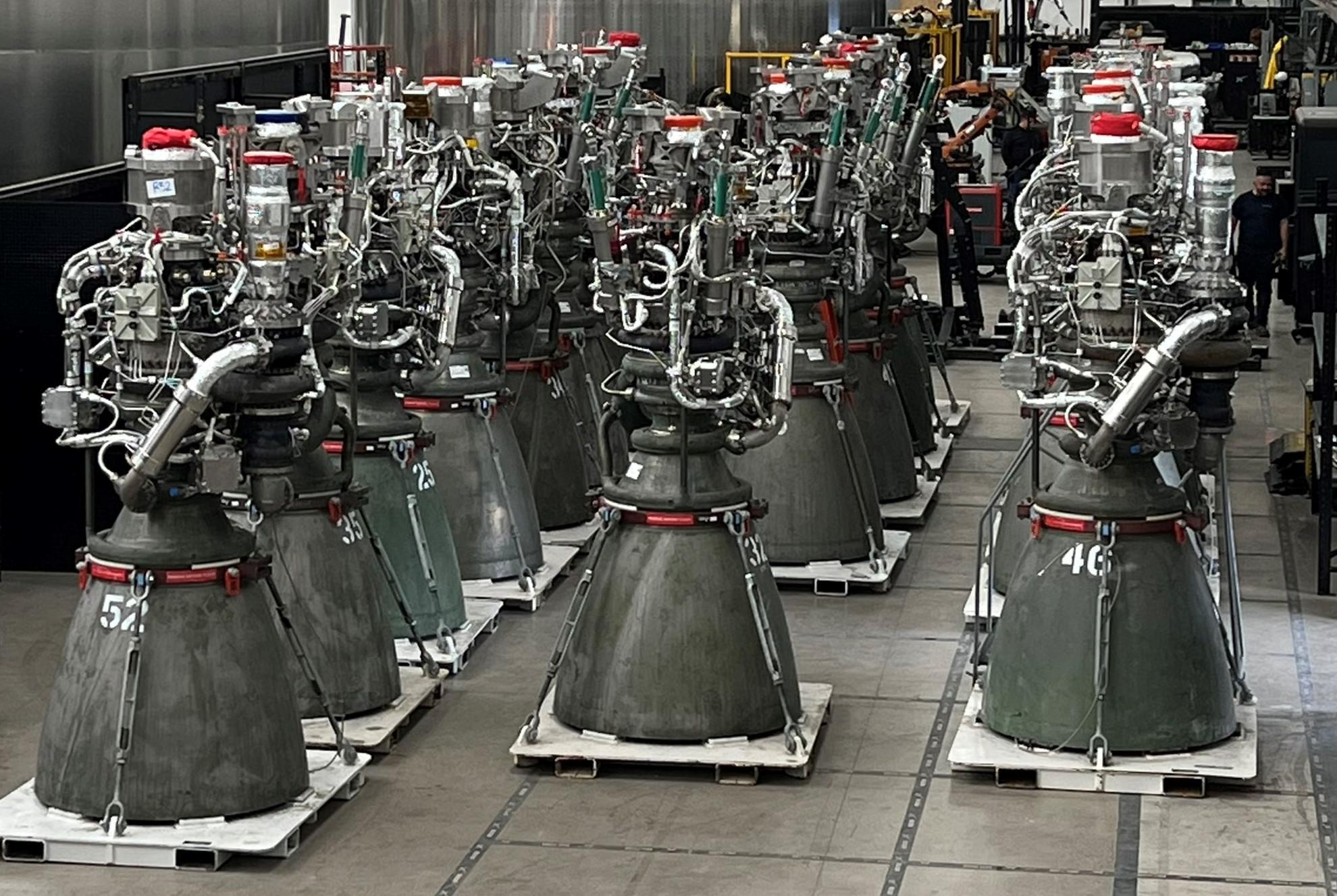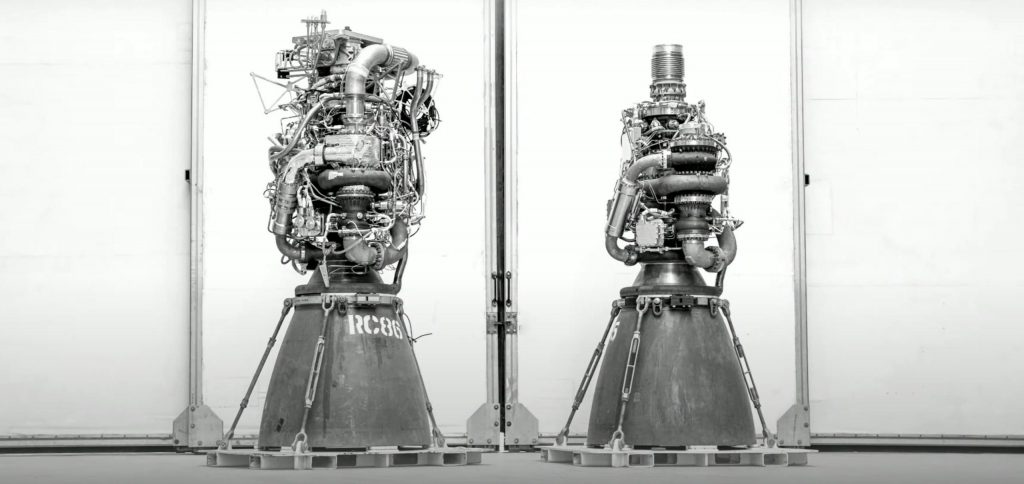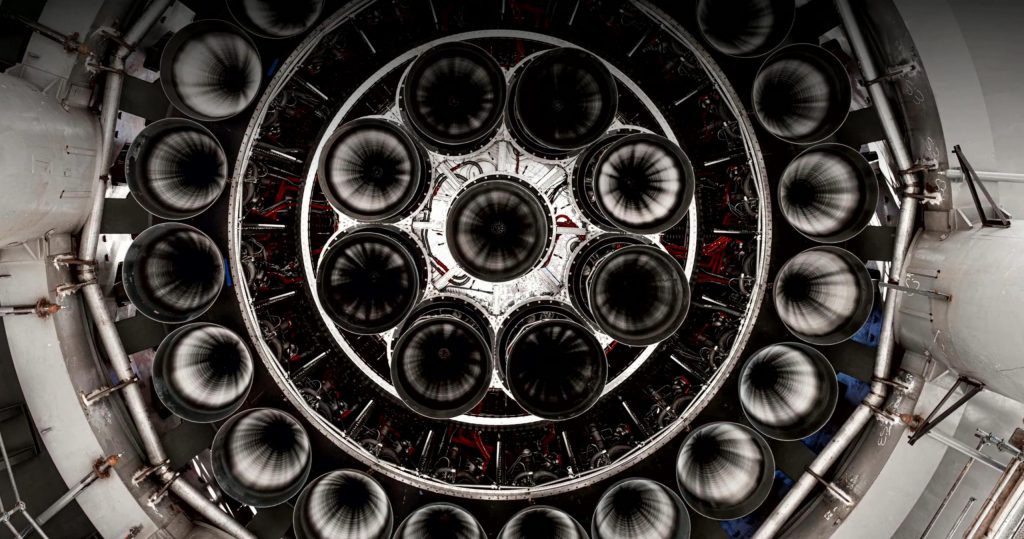

News
SpaceX rapidly shipping upgraded Raptor engines to Starbase
SpaceX appears to have opened the floodgates and begun shipping upgraded ‘Raptor V2’ engines to Starbase en masse in preparation for crucial Starship and Super Heavy testing.
The first functional Raptor engine delivery in around half a year and the first Raptor V2 delivery ever appeared to arrive at Starbase on March 30th. About a month and a half prior, SpaceX brought an early Raptor V2 prototype damaged during testing to serve as a backdrop for CEO Elon Musk’s February 10th Starship presentation, marking the first time the public was allowed to see or photograph the engine up close.
Less than three months later, Raptor V2 engines that passed proof testing without damaging or destroying themselves have begun to rapidly pile up inside one of Starbase’s three main production tents.
Though Raptor V2 has plenty in common with its Raptor V1 and V1.5 predecessors and, for the most part, looks very similar, Musk has repeatedly stated that the engine represents a major evolution from past Raptors. Most importantly, Raptor V2 was designed to significantly cut production cost and time. To achieve that, almost every major component was either fully redesigned, tweaked, or refined in some way to make Raptor simpler and more compact.
One example is the decision to slash the number of flanges (mechanical joints) in the engine’s plumbing by replacing them with welds. Making plumbing more monolithic could remove dozens of parts, seals, and potential leak points and significantly speed up manufacturing at the cost of making it harder – if not impossible – for SpaceX to inspect and replace certain pipes or pipe sections in a modular manner.

That process was repeated throughout each Raptor system, resulting in an engine that looks more streamlined than earlier variants. As a result of its more refined design and improvements to other critical components, Musk says that even though Raptor V2 now costs about half as much to build as V1.5, it’s also “much more…reliable.”
Despite significantly improving Raptor’s reliability, simplicity, and cost, SpaceX also managed to boost its maximum thrust by almost 25%. Raptor V2 engines now “routinely” operate at record-breaking main combustion chamber pressures of 300+ bar (~4400 psi) and are able to produce up to 230 tons (~510,000 lbf) of thrust at sea level. The older Raptor V1.5 engines that flew on Starships SN8-SN11 and SN15 and were installed on Super Heavy Booster 4 and Ship 20 were designed to produce around 185 tons (~410,000 lbf) at 250 bar (~3600 psi).
Following the premature retirement of Super Heavy Booster 4 (B4), which was meant to help send Starship S20 to space on the rocket’s first orbital launch attempt, that orbital launch debut is now guaranteed to use a different booster and ship powered by Raptor V2 engines. Ship 24 is a strong candidate for the mission’s Starship, while it remains to be seen if SpaceX will fully repair and attempt to proceed with Booster 7 or if Booster 8 – which is almost complete – will take point.
Either way, the pair will need at least 39 qualified Raptor V2 engines to begin integrated testing, pass several major static fire milestones, and prepare for flight. Since SpaceX appeared to kick off Raptor V2 deliveries to Starbase on March 30th, a photo shared by Musk on April 26th revealed that the company has managed to deliver at least 18 of the upgraded engines in the last four weeks. At least one more engine was also delivered on April 28th.

That means that SpaceX already has enough engines to begin static fire tests with a full cluster of 13 central Raptors on Super Heavy B7 or B8. By the time Ship 24 is fully assembled, Booster 7 is repaired, or Booster 8 is completed, there’s a good chance that SpaceX will have all the engines it needs to fully outfit a Starship and Super Heavy pair – not quite by the end of April, as Musk predicted, but not far off.

Elon Musk
Elon Musk and Tesla AI Director share insights after empty driver seat Robotaxi rides
The executives’ unoccupied tests hint at the rapid progress of Tesla’s unsupervised Robotaxi efforts.

Tesla CEO Elon Musk and AI Director Ashok Elluswamy celebrated Christmas Eve by sharing personal experiences with Robotaxi vehicles that had no safety monitor or occupant in the driver’s seat. Musk described the system’s “perfect driving” around Austin, while Elluswamy posted video from the back seat, calling it “an amazing experience.”
The executives’ unoccupied tests hint at the rapid progress of Tesla’s unsupervised Robotaxi efforts.
Elon and Ashok’s firsthand Robotaxi insights
Prior to Musk and the Tesla AI Director’s posts, sightings of unmanned Teslas navigating public roads were widely shared on social media. One such vehicle was spotted in Austin, Texas, which Elon Musk acknowleged by stating that “Testing is underway with no occupants in the car.”
Based on his Christmas Eve post, Musk seemed to have tested an unmanned Tesla himself. “A Tesla with no safety monitor in the car and me sitting in the passenger seat took me all around Austin on Sunday with perfect driving,” Musk wrote in his post.
Elluswamy responded with a 2-minute video showing himself in the rear of an unmanned Tesla. The video featured the vehicle’s empty front seats, as well as its smooth handling through real-world traffic. He captioned his video with the words, “It’s an amazing experience!”
Towards Unsupervised operations
During an xAI Hackathon earlier this month, Elon Musk mentioned that Tesla owed be removing Safety Monitors from its Robotaxis in Austin in just three weeks. “Unsupervised is pretty much solved at this point. So there will be Tesla Robotaxis operating in Austin with no one in them. Not even anyone in the passenger seat in about three weeks,” he said. Musk echoed similar estimates at the 2025 Annual Shareholder Meeting and the Q3 2025 earnings call.
Considering the insights that were posted Musk and Elluswamy, it does appear that Tesla is working hard towards operating its Robotaxis with no safety monitors. This is quite impressive considering that the service was launched just earlier this year.
Elon Musk
Starlink passes 9 million active customers just weeks after hitting 8 million
The milestone highlights the accelerating growth of Starlink, which has now been adding over 20,000 new users per day.

SpaceX’s Starlink satellite internet service has continued its rapid global expansion, surpassing 9 million active customers just weeks after crossing the 8 million mark.
The milestone highlights the accelerating growth of Starlink, which has now been adding over 20,000 new users per day.
9 million customers
In a post on X, SpaceX stated that Starlink now serves over 9 million active users across 155 countries, territories, and markets. The company reached 8 million customers in early November, meaning it added roughly 1 million subscribers in under seven weeks, or about 21,275 new users on average per day.
“Starlink is connecting more than 9M active customers with high-speed internet across 155 countries, territories, and many other markets,” Starlink wrote in a post on its official X account. SpaceX President Gwynne Shotwell also celebrated the milestone on X. “A huge thank you to all of our customers and congrats to the Starlink team for such an incredible product,” she wrote.
That growth rate reflects both rising demand for broadband in underserved regions and Starlink’s expanding satellite constellation, which now includes more than 9,000 low-Earth-orbit satellites designed to deliver high-speed, low-latency internet worldwide.
Starlink’s momentum
Starlink’s momentum has been building up. SpaceX reported 4.6 million Starlink customers in December 2024, followed by 7 million by August 2025, and 8 million customers in November. Independent data also suggests Starlink usage is rising sharply, with Cloudflare reporting that global web traffic from Starlink users more than doubled in 2025, as noted in an Insider report.
Starlink’s momentum is increasingly tied to SpaceX’s broader financial outlook. Elon Musk has said the satellite network is “by far” the company’s largest revenue driver, and reports suggest SpaceX may be positioning itself for an initial public offering as soon as next year, with valuations estimated as high as $1.5 trillion. Musk has also suggested in the past that Starlink could have its own IPO in the future.
News
NVIDIA Director of Robotics: Tesla FSD v14 is the first AI to pass the “Physical Turing Test”
After testing FSD v14, Fan stated that his experience with FSD felt magical at first, but it soon started to feel like a routine.

NVIDIA Director of Robotics Jim Fan has praised Tesla’s Full Self-Driving (Supervised) v14 as the first AI to pass what he described as a “Physical Turing Test.”
After testing FSD v14, Fan stated that his experience with FSD felt magical at first, but it soon started to feel like a routine. And just like smartphones today, removing it now would “actively hurt.”
Jim Fan’s hands-on FSD v14 impressions
Fan, a leading researcher in embodied AI who is currently solving Physical AI at NVIDIA and spearheading the company’s Project GR00T initiative, noted that he actually was late to the Tesla game. He was, however, one of the first to try out FSD v14.
“I was very late to own a Tesla but among the earliest to try out FSD v14. It’s perhaps the first time I experience an AI that passes the Physical Turing Test: after a long day at work, you press a button, lay back, and couldn’t tell if a neural net or a human drove you home,” Fan wrote in a post on X.
Fan added: “Despite knowing exactly how robot learning works, I still find it magical watching the steering wheel turn by itself. First it feels surreal, next it becomes routine. Then, like the smartphone, taking it away actively hurts. This is how humanity gets rewired and glued to god-like technologies.”
The Physical Turing Test
The original Turing Test was conceived by Alan Turing in 1950, and it was aimed at determining if a machine could exhibit behavior that is equivalent to or indistinguishable from a human. By focusing on text-based conversations, the original Turing Test set a high bar for natural language processing and machine learning.
This test has been passed by today’s large language models. However, the capability to converse in a humanlike manner is a completely different challenge from performing real-world problem-solving or physical interactions. Thus, Fan introduced the Physical Turing Test, which challenges AI systems to demonstrate intelligence through physical actions.
Based on Fan’s comments, Tesla has demonstrated these intelligent physical actions with FSD v14. Elon Musk agreed with the NVIDIA executive, stating in a post on X that with FSD v14, “you can sense the sentience maturing.” Musk also praised Tesla AI, calling it the best “real-world AI” today.








